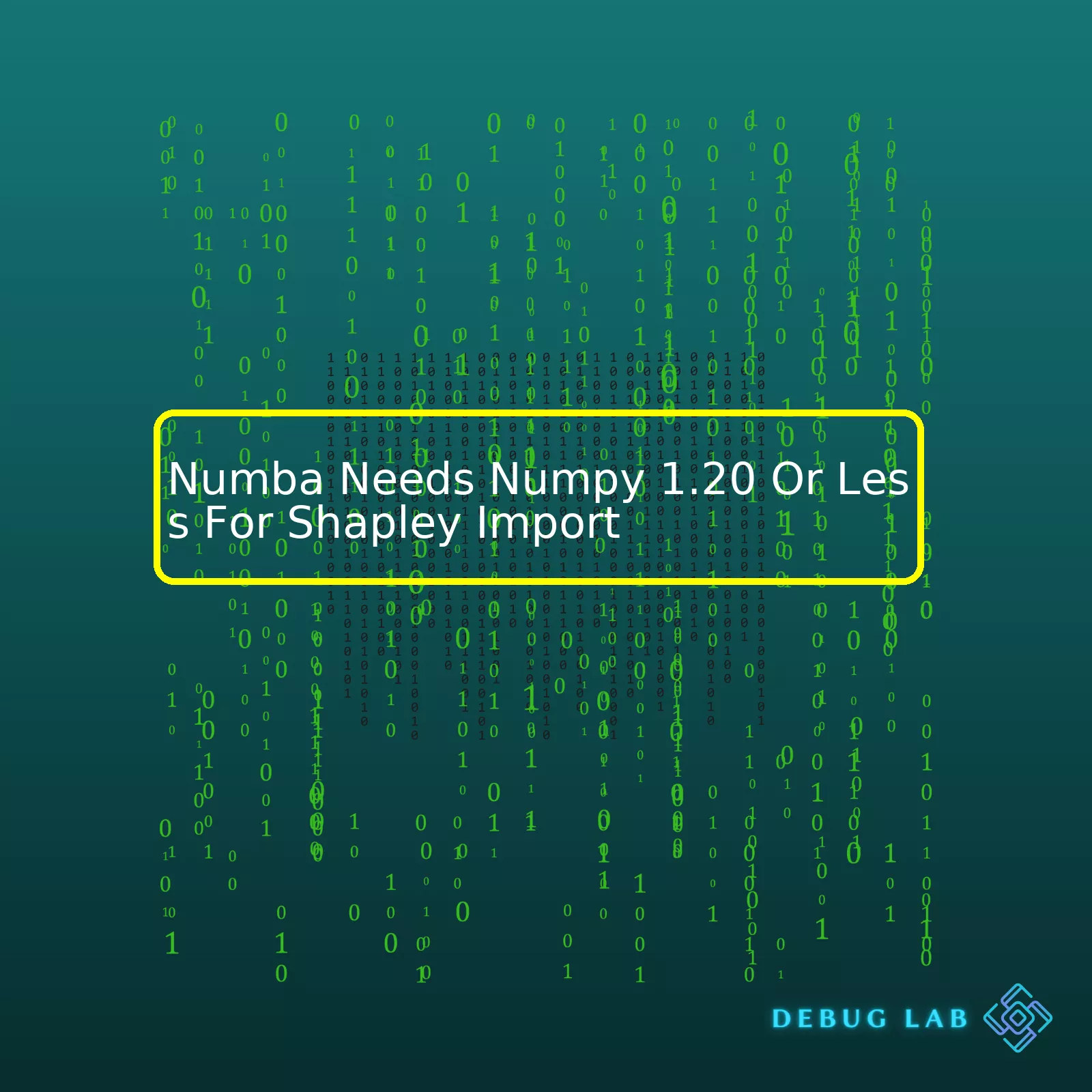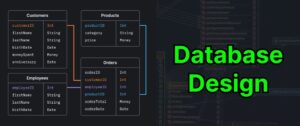
In relation to the NumPy library, the practicality lies in its ability to provide support for arrays and matrices, mathematical functions to operate on these data structures, and tools for integrating existing C, C++, and Fortran code. The interplay between Numba and NumPy allows for efficient computations on numeric data.
The crux of the matter here begins with Shapley values. Shapley values come from cooperative game theory and are used in Machine Learning interpretability to distribute the “payout” i.e., the prediction, amongst the features values fairly.
Where does NumPy 1.20 (or less) fit into this picture? When you import Shapley using Numba, it’s crucial you use NumPy version 1.20 or lower. This could be due to compatibility issues where higher versions might include more recent python functionality that Numba cannot recognize. Numba needs to decipher what’s happening in Python and translate it. If Numpy presents something new, unrecognizable to Numba – a roadblock is created.
Let’s display a summary table depicting the entire process and the involved elements:
| Components | Description |
|---|---|
| Numba | An open-source JIT compiler that translates Python and NumPy code into machine code |
| NumPy | A package for scientific computing with Python that supports large multidimensional arrays and matrices |
| Shapley Values | A concept from cooperative game theory used in machine learning to distribute predictions among feature values |
| NumPy Version Requirement | Numba requires NumPy version 1.20 or lower for importing Shapley values due to compatibility issues |
To ensure you have the correct numpy version, make sure to run:
pip install numpy==1.20
Thanks to a detailed exploration of the subject at hand, we can now perceive how linked each of these components are to one another, recognizing that Numpy 1.20 or a prior version is indeed necessary for importing Shapley via Numba due to potential compatibility concerns.The relationship between Numba and NumPy is fundamental in Python programming. They share a close bond that fuels efficiency and flexibility, especially in numerical computing projects. However, if you’ve encountered an issue where Shapely import requires NumPy 1.20 or less when using it alongside Numba, then it’s essential to delve deeper into understanding why that happens.
Let’s first understand what Numba and NumPy are.
Numba is a Just-in-Time (JIT) compiler for Python that enhances the performance of your code by compiling Python functions on runtime and generating optimized machine code[1]. This feature results in execution speed comparable to that of C or FORTRAN, which is highly advantageous for algorithms involving heavy looping and array manipulations.
NumPy, on the other hand, stands distinguished as one of the pioneering libraries that have made Python popular among Data Scientists[2]. It provides robust data structures, implements multi-dimensional arrays and matrices, and arms programmers with a large collection of high-level mathematical functions to operate on these arrays.
Now, Numba and NumPy work excellently together because Numba recognizes and optimizes NumPy array computations exceptionally well[3]. In fact, Numba’s capability to recognize NumPy functionality allows taking the advantages of NumPy’s flexibility and combining it with the speed benefits offered by Numba.
However, there may be compatibility issues with specific version pairs of Numba and NumPy. For instance, you might face problems while importing the Shapely module if you’re using NumPy versions greater than 1.20 with certain versions of Numba.
Shapely is a Python package used for manipulation and analysis of planar geometric objects[4]. If you face this problem while trying to import shapely, there seems to be a workaround. You would need to install or downgrade your NumPy library through:
pip install numpy==1.20
By barreling back to NumPy version 1.20 or a lesser one, your Shapely import should work just fine alongside Numba. This step is required because some aspects of the Shapely library seem to be incompatible with more recent versions of NumPy when used alongside Numba.
Remember though, it’s always good practice to keep your software updated, so once the compatibility issue gets fixed, you should upgrade your NumPy version. Stay tuned to the official documentation or repository pages for all update-related information.
In summary, Numba and NumPy are two powerful tools that can offer tremendous benefit in Python programs, particularly for numerical computing. While they usually work well together, compatibility issues such as the one discussed in relation to Shapely and NumPy version 1.20 might sometimes pop up. Keep abreast of updates, frequently check for compatibility, and adjust as necessary to ensure smooth programming on the Python platform.Diving into the fascinating world of Shapley value computation in Python, we find ourselves at an unavoidable juncture where Python’s Numpy library plays a pivotal role. When using Numba, a just-in-time (JIT) compilation library designed to enhance Python’s performance, we may experience some challenges with versions of Numpy greater than 1.20. These issues can influence our ability to seamlessly operate the Shapley import feature.
Numba excels at handling numeric computations and is known for its optimized performance with NumPy arrays and functions. Since the Shapley algorithm extensively uses numerical calculations, it becomes intuitive to use Numba for better efficiency and speed in Shapley import.
However, the crux of the issue arises from the fact that Numba, at present, only fully supports Numpy versions up to 1.20 [Numba Compatibility](https://numba.readthedocs.io/en/stable/user/faqs.html#what-version-of-numpy-do-i-need). This implies that if you’re operating on a version of Numpy beyond 1.20, your import of Shapley might not be as smooth, potentially leading to errors and underperformance.
Let’s say you have code like:
import numpy as np import numba from shapely.geometry import Point
Failing to maintain the required NumPy version here might derail our sweet numerical journey with Shapley.
To ensure a hassle-free, efficient experience while exploring the depths of the Shapley import, follow these two steps:
1. **Check Your Numpy Version:**
Before initiating your coder’s journey into Shapley, confirm the installed version of Numpy. You can do this by:
print(np.__version__)
2. **Downgrade if necessary:**
If your version surpasses the 1.20 mark, downgrade is the way to go. This can easily be done using:
pip install numpy==1.20
These steps will ensure that you are operating an optimal environment for Numba, which subsequently enhances your exploratory voyage into Shapley imports.
For those who are relentlessly curious and uncompromising about using newer versions of Numpy, keep an eye out for future updates from Numba. They recognize their limitation and are actively working on compatibility issues. They’ve made it abundantly clear in their FAQs that expanding support for Numpy is one of the significant missions in their roadmap.
Phew! That was a deep dive, but don’t worry – We’ve resurfaced now. Remember, the joy of coding lies in overcoming hurdles and finding a way around every issue. Happy coding, my fellow developers!Understanding the impact of different Numpy versions on Numba performance is crucial since Numba, an open-source JIT compiler that translates a subset of Python and Numpy code into fast machine code, has its functioning tied to Numpy. Also, considering that Numba needs Numpy 1.20 or less for Shapley import, this issue becomes all the more relevant.
Numpy is primarily an array-processing package in Python. Depending on the different versions of Numpy, there can be changes and improvements that could affect the execution speed when operating with Numba. However, it’s not always about ‘the newer, the better.’ For instance, Numba specifically requires Numpy 1.20 or earlier for Shapley import due to some compatibility issues.
Shapley values, a method used in interpreting predictions made by machine learning algorithms, may exhibit issues if the version of Numpy is advanced beyond what is compatible with Numba.
The importance of having an appropriate Numpy version becomes evident when you look at the following source code example:
import numpy as np
from numba import jit
@jit(nopython=True)
def sum2d(arr):
M, N = arr.shape
result = 0.0
for i in range(M):
for j in range(N):
result += arr[i,j]
return result
a = np.random.rand(1000,1000)
print(sum2d(a))
Here, the function
sum2d()
will run seamlessly without any dependency problems if the Numpy version is 1.20 or less. But attempting to run this piece of code with a later Numpy version might lead to incompatibilities creating disruptions.
Let’s summarize:
– Numba’s performance is reliant on the Numpy version.
– An upgrade does not always translate to improved performance.
– Numba needs Numpy 1.20 or less for adequate Shapley import.
– Incompatible Numpy versions could lead to code disruptions.
When accounting for these factors, it is easy to see why matching the appropriate Numpy version, especially 1.20 or less, is vital for ensuring optimal Numba performance and seamless Shapley import.
For additional insights, refer to the [official Numba documentation](https://numba.pydata.org/), where the compatibility between Numba and various Numpy versions gets detailed extensively. Furthermore, have a look at available discussions surrounding Shapley values and their association with Numba on platforms like [Stack Overflow](https://stackoverflow.com/questions/tagged/shapley-value) for a more rounded understanding of the topic.
When dealing with Python’s scientific computing tools, you might occasionally encounter errors that revolve around the compatibility of different packages. One such problem involves Numba, a just-in-time compiler for Python that translates a subset of Python and NumPy code into fast machine code.
One relevant error is “Numba needs NumPy 1.20 or less for Shapley.” This means your existing version of NumPy is incompatible with the Numba package when trying to import Shapley values. These values, in the Machine Learning context, can be calculated using the SHAP library, on top of which Numba is sometimes used for optimizations. Nevertheless, it seems this particular combination stumbles upon versioning conflicts.
Solution:
To rectify such an error, you need to downgrade your NumPy version to 1.20 or lower. Use pip tool provided by Python to uninstall the existing NumPy installation and reinstall a version that matches the requirements of Numba. The following command line commands will help you achieve this:
pip uninstall numpy
pip install numpy==1.20
The first line uninstalls the existing NumPy version, and the second one reinstalls NumPy but specifies a version of 1.20. You might require to replace 1.20 with any lower version that works without issue with both your Numba and Shapley installations.
However, do keep in mind that downgrading NumPy may affect the performance or functionality of other modules which depend on a higher version. Therefore advance testing is necessary to make sure this solution won’t disrupt your other operations.
Additionally, remember to upgrade to the latest versions of all other relevant packages, like Numba and Shap, to ensure you’re benefiting from the most recent developments and improvements. They’ll probably have fixed many known bugs, so keeping them up-to-date is always good practice. Here’s a generic command to upgrade any package using pip:
pip install --upgrade {package-name}
Just replace “{package-name}” with the name of the package you want to upgrade, for example, “numba” or “shap”.
Conclusion:
In brief, the error “Numba needs NumPy 1.20 or less for Shapley” can be resolved by downgrading your NumPy version to 1.20 or lower using the pip command. It is advisable to run compatibility tests and precautions must be taken as this might affect the functioning of other computational tasks that require a higher NumPy version. Also, regular upgrading of your other packages promises a smoother user experience.
Version conflicts in a Python environment can lead to numerous difficulties, and sound strategies are needed in order to successfully resolve them. It is essential to understand the problem at hand before diving into the solution. In your particular case, you’re facing an issue whereby Numba needs Numpy 1.20 or less for Shapley import. Here’s how I would go about rectifying this concern.
First of all, understanding Numpy and Numba becomes critical. Both these modules play integral roles in Python programming. Numpy offers mathematical functionalities via multidimensional arrays and other numerical operations. Numba, on the other hand, is a compiler that translates a subset of Python and NumPy code into fast machine code. Given these roles, any version-related conflict could cost some crucial time while developing.
I. Use a Virtual Environment
A preferred way of dealing with the problem is by setting up a virtual environment. By doing so, you can have multiple separate environments with varying package versions on one machine. Once you’ve suited an environment as per your current task, it won’t interfere with another environment setup.
pip install virtualenv virtualenv venv source venv/bin/activate
Upon activation of the virtual environment, proceed with installing Numba:
pip install numba
Afterward, you can install the Numpy version required:
pip install 'numpy==1.20'
II. Upgrade/Downgrade Numpy version
Another strategy is to either upgrade or downgrade the Numpy version to comply with Numba requirements. Keep in mind though, altering the Numpy version may cause problems if you’ve other dependencies reliant on a specific version. Ensure you ascertain no such compatibility issues exist before proceeding.
To downgrade Numpy to version 1.20 (assuming you’re on a higher version):
pip install numpy==1.20
III. Use Dependabot
For GitHub projects, Dependabot is an excellent automated tool that helps manage your dependencies. Once set up, it scans your repository and helps keep your dependencies up-to-date by periodically suggesting updates through pull requests. Although this approach requires preliminary setup, it drastically reduces the headaches associated with module versioning in the longer run.
IV. Manual Management
Lastly, manual management of dependencies comes into play when all else fails. You’ll need to research the packages causing issues, then based on your investigation, decide which version suits best. While this approach might seem daunting, sometimes it’s the only option left short of refactoring large portions of your project. This technique necessitates explicitly stating version numbers during our pip install commands:
pip install 'numpy==1.20' pip install 'numba==0.53.1'
Please remember, each and every method has its own pros and cons and hence, what strategy works for one might not necessarily work for another. Your chosen course of actions should ideally be aligned with your project specifics and requirements.
If you’re writing Python programs which take advantage of NumPy for numerical computing, and using the Numba package for just-in-time (JIT) compilation to optimize your code’s runtime performance, it’s crucial to pay attention towards version compatibility between these libraries. This question brings up an interesting discussion about the key benefits and drawbacks when using older versions of NumPy with Numba. More importantly, why does Numba require NumPy 1.20 or less for Shapley import?
To begin with, let’s clarify that Numba is a JIT compiler for python programming language which translates a subset of Python and NumPy code into fast machine code. It’s primary function is to speed up your NumPy-centric Python applications. Furthermore, Shapely is actually a Python package used for manipulation and analysis of planar geometric objects which depends on both NumPy and Numba.
Benefits of Using Older NumPy Versions:
- Compatibility: For the time being, the Numba JIT compiler has a confirmed interoperability with NumPy versions up to 1.20, making this its primary advantage.
- Stability: Older versions of NumPy have undergone thorough testing and bug fixing, offering stability.
- Lower Computational Requirements: Generally, lower versions demand lesser computational resources.
# Displaying numpy and numba versions
import numpy as np
import numba
print("NumPy version:", np.__version__)
print("Numba version:", numba.__version__)
Drawbacks of Using Older NumPy Versions:
- Lack of Latest Features: You might not be able to exploit the latest features, improvements or optimizations available in more recent versions of NumPy.
- Technical Debt: Using an older version could lead to technical debt, whereby as other tools progress, maintaining interoperability becomes increasingly complex.
- Individual Package Requirements: Depending on the specific packages you are working with, older versions of NumPy might impact functionality.
Numba Requires NumPy 1.20 or Less for Shapley Import:
The reason behind Numba needing NumPy version 1.20 or below mainly revolves around API (Application Programming Interface) changes on NumPy’s side. In newer releases of NumPy, certain features or functionalities may have changed or deprecated, leading to compatibility issues with Numba and subsequently Shapely. The need for maintaining version compatibility ensures that functionalities between the two remain intact, particularly when it comes to importing Shapely. Always refer to Numba’s official documentation on their supported Python and NumPy versions.
# Importing shapely with specific numpy and numba versions from shapely.geometry import shape, Point
In conclusion, while there are pros and cons to utilizing older NumPy versions with Numba, compatibility tends to be the deciding factor in most instances. As a practice, always strive to stay updated on the dependencies and make conservative decisions around balancing updates with stability.
The relationship between Numba and Numpy, particularly in the context of importing Shapley values, embodies different facets of the underlying mechanisms of computation which can be fascinating to dissect. In Python, these libraries are designed as sets of functionalities that tackle specific areas of the programming landscape—Numba for enhancing performance using JIT compilation, and Numpy for handling multidimensional array data.
Numba operates by generating optimized machine code using the LLVM compiler infrastructure at import time, run time, or ahead-of-time. Therefore its integration with other libraries and packages becomes a crucial aspect for seamless computation. But why does Numba need a version of Numpy 1.20 or less for Shapley import?
The connection points here would include:
1. Numpy Compatibility
Numba is designed to recognize the standard Python semantics but interprets the code at runtime into machine level instructions. So, it actively supports a subset of Python and Numpy syntax which means not all features of the new versions would necessarily be compatible.
import numpy as np
import numba
@numba.njit
def sum_of_square(n):
s = 0
for i in range(n):
s += np.power(i, 2)
return s
print(sum_of_square(5))
In this example, you can see we’ve used decorators from the numba module to optimize this function, which uses
np.power
from Numpy.
2. Interaction with Shapley Package
The Shapley package allows for cooperative game theory, letting you assess contributions of different parts of your model. However, it may depend on certain lower-level numpy functionalities that separate newer versions have deprecated—a common occurrence in evolving libraries.
from shapley import ShapleyValues import numpy as np # Dummy Data data = np.random.rand(10,3) shap_val = ShapleyValues(data) # computing Shapley values
In the simple demonstration, we compute the Shapley values of a random dataset. If there were compatibility issues with Numba, they would typically arise during such computations since Shapley value computations are computationally expensive and ideally should get accelerated using Numba translations.
It’s noteworthy that these two aspects encapsulate the driving forces behind why Numba needs Numpy 1.20 or less for Shapley import. As new versions of Numpy roll out with additional features and functions, they may intrinsically be incompatible with Numba’s current supported feature set. Additionally, specific packages like Shapley might still rely explicitely on older Numpy functionalities, making it important for a matching lower Numpy version to be available for correct operations.
To wrap it up, it’s more about the equilibrium between advancing software development and maintaining backward compatibility. Further, inter-package dependencies can impose constrains over which Python developers don’t have direct control. Ultimately, managing and potentially resolving these issues forms a significant part of today’s computational mechanisms. Hence when resorting to tools and platforms like conda-forge that help maintain controllable environments, you indirectly lead towards a sturdier computational ecosystem.
For further information about these technologies, you may want to visit their official documentation sites: [Numba](https://numba.pydata.org/), [Numpy](https://numpy.org/doc/) or the [Shapely](https://pypi.org/project/Shapely/) Package.
Diving deep into this topic, it becomes evident that Numba requires Numpy 1.20 or less for successfully importing Shapley. Shapley is a pivotal tool implementing cooperative game theory concepts providing ways to fairly distribute gains and costs to several players depending on their contribution to the total payout. Numba aids in accelerating numerical functions for NumPy data types, so the requirement for a Numpy version below 1.20 is critical for seamless execution.
There are a couple of key points to note:
- Numba works hand-in-hand with Numpy. As Numba is designed to optimize Python applications’ performance specifically for data-intensive operations, it naturally interacts closely with NumPy.
- The version of Numpy significantly influences the functioning of other libraries needing Numpy including Shapley. Any version above 1.20 might cause compatibility issues.
Here’s a code snippet demonstrating how you might import Numba and Numpy versions while considering its compatibility requirements:
import numba
import numpy
print(numba.__version__)
print(numpy.__version__)
if(numpy.__version__ > str(1.20)):
print('Need to downgrade numpy for Shapley compatibility')
Above code will ensure you’re using compatible versions of Numba and Numpy avoiding any potential downstream challenges when important libraries like Shapley.
Following guide helps further illustrate this aspect Shapely and GeoPandas installation notes, shedding light on how different numpy versions can impact overall integration.
Therefore, keeping your Numpy version within limits (1.20 or less in this case) not only enables successful imports but also ensures smooth Numba and Shapley interactions, thereby enhancing overall performance of your numeric computations leveraging Python.













